What is a viola da gamba?
A string instrument that was very popular in Europe during the Renaissance and Baroque eras. To our modern eyes, it looks like a large guitar but played vertically and with a bow.
It has a similar sound to that of a cello, but with a quieter and airier quality.
Viols always have frets (like guitars), most often 6 strings (like guitars) which are made out of animal gut. The open strings are tuned in fourths, except for one third in the middle (guess what: almost like a guitar).
Viols come in slightly different shapes but all are held vertically between the legs. Hence, the Italians called the instrument viola da gamba, literally a ‘leg fiddle’. Whether you say viol (which rhymes with ‘smile’), viola da gamba, or just gamba, doesn’t matter: these names all refer to the same family of instruments.
Fly over the instrument to discover the different parts
A consort of viols : the Little Light Consort Ensemble
When was the viol invented? A little history

From Spain to Italy
As with many things that have been around for over 500 years, it is impossible to pinpoint exactly when and where the viol first appeared. While competing theories exist, the instrument is widely regarded to have originated in 15th century Spain, where iconography shows instruments bowed while held vertically between the knees. This practice was probably borrowed from the Moorish rebab and applied to the Spanish vihuela – itself a predecessor of the guitar.
This flat-bridged bowed vihuela is thought to have made its way from Spain to Italy with Alexander VI, Pope from 1492 to 1503 and member of the Catalan Borgia dynasty. He brought a surge of Catalan culture to Rome and with it an influx of Spanish musicians and instruments.
By the middle of the 16th century, composers such as Ganassi and Ortiz had started to explore the melodic potential of the instrument and a solo repertoire had emerged. Whether part of a consort or as a soloist, the viola da gamba was most present at court and highly sought after for glamorous events such as weddings.
« When one string is touched, others remain untouched »
in De inventione et usu musicae, Tinctoris, ca. 1487.
Throughout the 16th century, iconography as well as surviving instruments reveal a remarkable kaleidoscope of viols of different shapes and sizes in Italy. This shows how much luthiers experimented to eventually bring the viola da gamba into its « classic » form – a form that would ensure its survival for the next two centuries, chiefly by arching the bridge to make it suitable for solo playing. Once equipped with an arched bridge, a player could easily make one string sound at a time, without touching the others, and develop a mastery of independent musical lines.
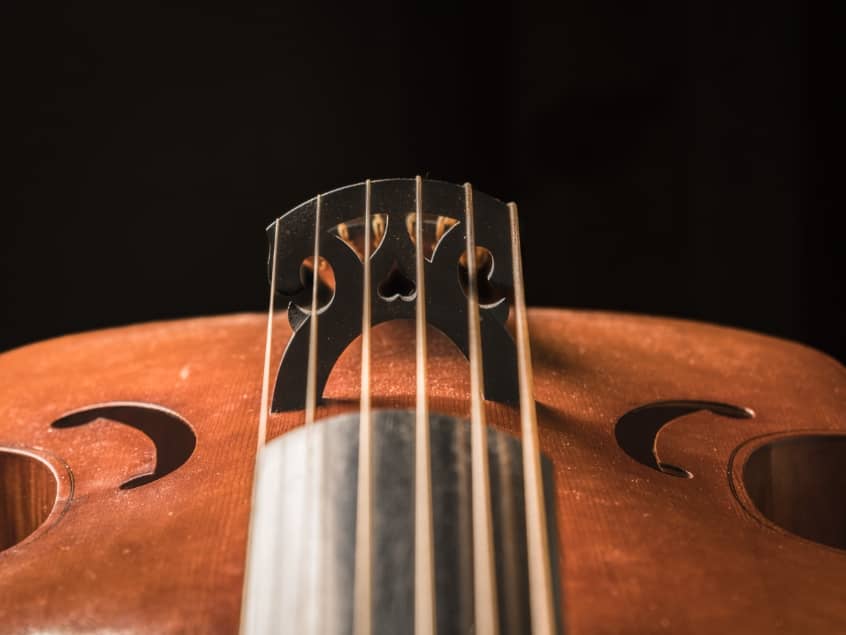
Across the Alps…
While thriving and developing in Italy, the viol crossed the Alps towards German-speaking south-central Europe – from Basel to Vienna. No less than eight depictions of the instrument appear in books between 1511 and 1546. But most importantly, playing the viol stopped being the exclusive practice of professional musicians and courtly life; by embracing consort playing, gentlemen and merchants allowed the instrument to gain a new « amateur » status and therefore insured its larger distribution.
…and overseas
Employed at the English court, Italian musicians brought their music and instruments along. The first violists probably appeared at the English court around 1515. An inventory of Henry VIII’s instruments, compiled at the time of his death in 1547, reveals that his prized collection of “newe vialles” was substantial in both quantity and quality, and that, by extension, the instrument was rapidly gaining popularity at court.
In Tudor and Elizabethan England, music for viol consort flourished. A new generation of composers – among them William Byrd, Thomas Morley, Alfonso Ferrabosco II, John Dowland, Thomas Tomkins and Orlando Gibbons – exploited the possibilities of the instrument through sonorous polyphonic pieces like pavans, dances, consort songs, fantasias or In Nomine.
Two peculiar virtuoso techniques became very fashionable over the 17th century. The first was the lyra way, which referred to a highly polyphonic way of playing, that is to say with many chords; sometimes the instrument would even be tuned differently to fit the tonality of the piece better. The second fashion was to play virtuosic ornamented variations called divisions. With the emergence of these practices, instruction manuals designed to accompany the learner were published: the most famous one, Christopher Simpson’s The Division Viol (1659), encouraged a refining of bowing, posture, intonation, and fingering.
Yet, as solo playing expanded, consort practice began to die out. When the English golden age came to an end in the late 1600s, the name viola da gamba became synonymous with the normal-sized bass viol, as the other viols fell into disuse.
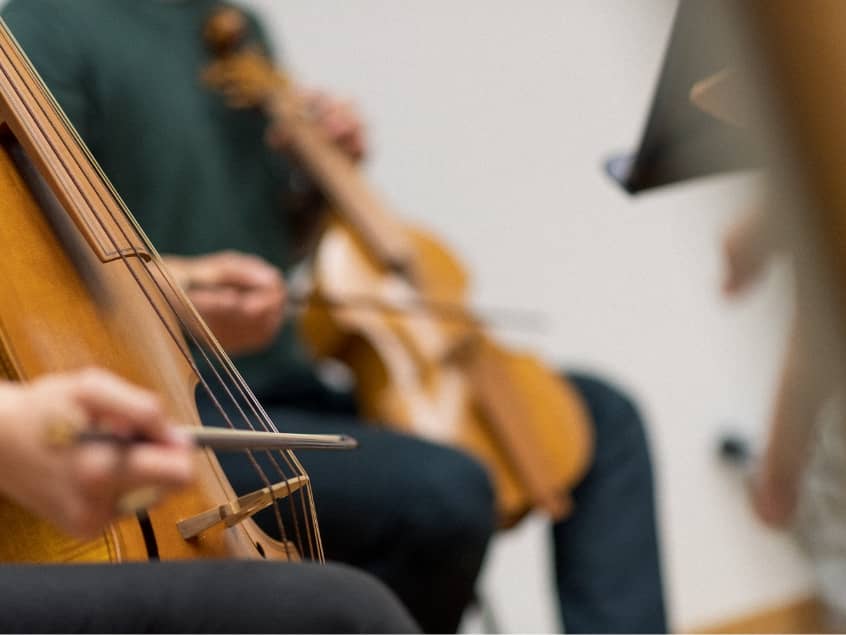
The French school
On its way to England in the course of the 16th century, the viol did not bypass Northern Europe: the growth of a viol-playing tradition in the households of the ruling families stimulated interest in the new instrument, which spread quickly throughout northern Germany, Holland, Denmark, France.
Like nowhere else, throughout the 17th century, the tradition of solo bass viol playing triumphed in France in the hands of Demachy, Jean de Sainte-Colombe and his student, the virtuoso Marin Marais. A seventh string was added to the bass instrument, increasing its range to the A below the low D and dramatically improving the viol’s capabilities for rich sonorities and expressive playing.
Consort, solo… and basso continuo
At the turn of the 17th century, the way of composing music gradually changed across Europe, switching from the Renaissance into what we now call the Baroque period. One of the main features of that new musical age was the emergence of the basso continuo, literally continuous bass in Italian. Most baroque pieces have a part labeled basso continuo: it is the bass line on which the whole composition is constructed, provided with numbers (or figures) indicating what harmonies should be heard and when.
By extension, the term also refers to the one or many instruments playing that basso continuo part, depending on the size of the ensemble. What you will find in a basso continuo group is, at the very least, an instrument capable of providing full harmonies – a keyboard (organ, harpsichord, fortepiano) or a plucked string instrument (lute, guitar, theorbo, harp). But very often, the bass line would be reinforced by one or several low-pitched melodic instruments: viol, cello, bassoon, double-bass.
All this goes to say that from roughly 1600 until 1750, across Europe, being a member of the continuo section was the main occupation for the bass viol, together with solo and consort playing.
As a teenager, I went to the school where my mother was teaching music. Of course, I felt a little pressure: I wanted to be good at it and make my mummy proud. One thing she would teach her classes was to listen to a piece of music and identify more or less in what period it had been composed. She would give us tricks to figure that out, and one of the easiest questions to start with was: "can you hear a basso continuo?". If the answer was yes, the good student I wanted to be would feel a joyful relief: no mistake possible, it was Baroque (1600-1750)!
Back then, I did not play the viol and I had no idea I would become a continuo player myself. But that's maybe where my love for the baroque basso continuo is rooted: by associating it to a feeling of certaintly and intelligibility... and to the guarantee of a good answer!
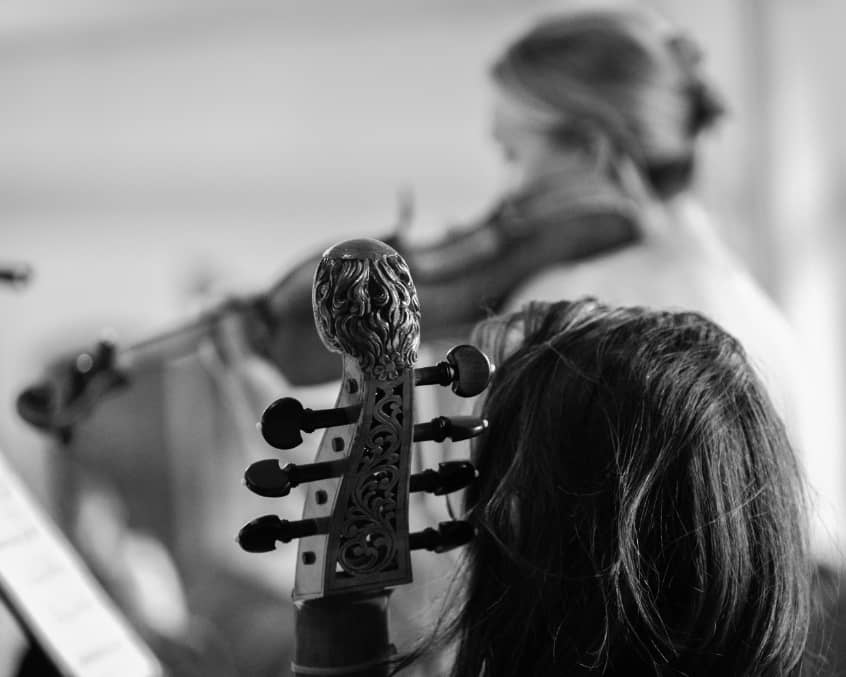
1700 - 1770 : last stops
In the beginning of the 18th century, the viol gradually started to be considered somewhat old-fashioned and would mostly stick to the continuo group. Yet it remained strongly present as a solo instrument wherever great performers carried on composing for it and defending its possibilities.
In France, Marin Marais (1656-1728) together with the last generation of violists – Forqueray, Caix d’Hervelois, etc. – produced some of the most beautiful pages of solo music ever written.
In Berlin, C. P. E. Bach, F. Benda and J. G. Graun kept on composing for viol at the court of Frederick the Great, mostly encouraged by the presence in the orchestra of L. C. Hesse, one of the last great virtuosi of the instrument. Johann Sebastian Bach wrote three sonatas for the bass viol and gave it prominent solo passagework in the St. John Passion, the St. Matthew Passion, and in numerous cantatas. Carl Friedrich Abel (1723-1787), friend of the Bach family, born in Germany but residing most of his life in England, is considered to be the last famous violist of the 18th century.
Bowing out
Over the second half of the 18th century, composers composing in the new Classical style began to write complete harmonies in the upper instrumental parts. The practice of building the harmonies from the basso continuo line died out and with it, the need for a basso continuo group. Some instruments like the theorbo were no longer needed.
The viol in particular could have theoretically carried on as a bass instrument of the orchestra or even a solo instrument, but the competition from the cello was too strong. Indeed, by the end of the 18th century, music stopped being the exclusive pleasure of the court and the Church. As the concept of public and paying concerts appeared, the need for more powerful instruments increased. The cello, louder and better suited to great virtuosity, gradually began to supplant the viola da gamba whose intimate nobility no longer fitted the new musical aspirations and the large concert halls.
During the 19th century, although viols never entirely disappeared (recent research has shown that works of Liszt, Mendelssohn & other composers of the Romantic period had been arranged for the viol), they certainly became rarer. Since their triumphant revival in the early 20th century, they are enthusiastically embraced by amateur and professional musicians alike.
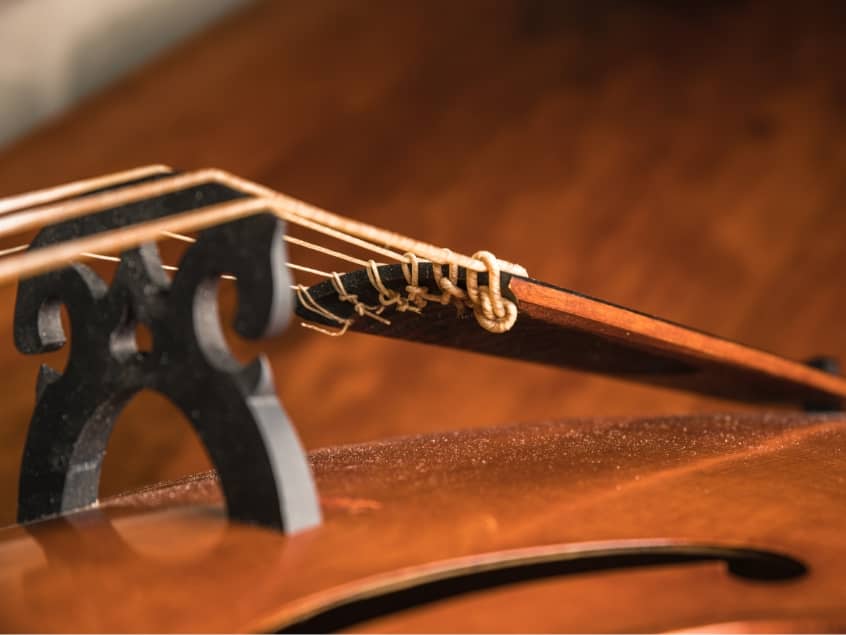
How do viols and celli differ exactly ?
The viol is not the ancestor of the cello! Despite their similarity in shape and sound, they were independent families, neither one descended from the other. The bass viol is one of several sizes that form the viola da gamba family, while the cello is the bass member of the violin family, more formally known as the viola da braccio family, literally ‘arm fiddles’. Even though the cello is held with the legs, it is really a large violin.
The louder violin family instruments were often viewed as the less refined cousins of the noble viols, the former better suited to dance music and the latter to the quieter social music making that was cultivated by amateurs and professionals at courts and domestic settings. Here are some of the chief differences distinguishing the two families:
Viola da gamba
six or seven strings
tuned in fourths, with a third in the middle
frets
bow held underhand, palm facing up
C-shaped holes
sloping shoulders
flat back with a bend near the top
deep ribs and thick body
square corners
usually more decorated with carved heads
Cello
four strings
tuned in fifths
no frets
bow held overhand, palm facing down
F-shaped holes
square shoulders
rounded curved back
shallow ribs and thin body
pointed corners
simple scrolls
While the above guidelines are the norm, there are many exceptions. During the 18th and 19th centuries, many viols were converted into cellos and others were constructed in a somewhat hybrid form including elements of both family types.
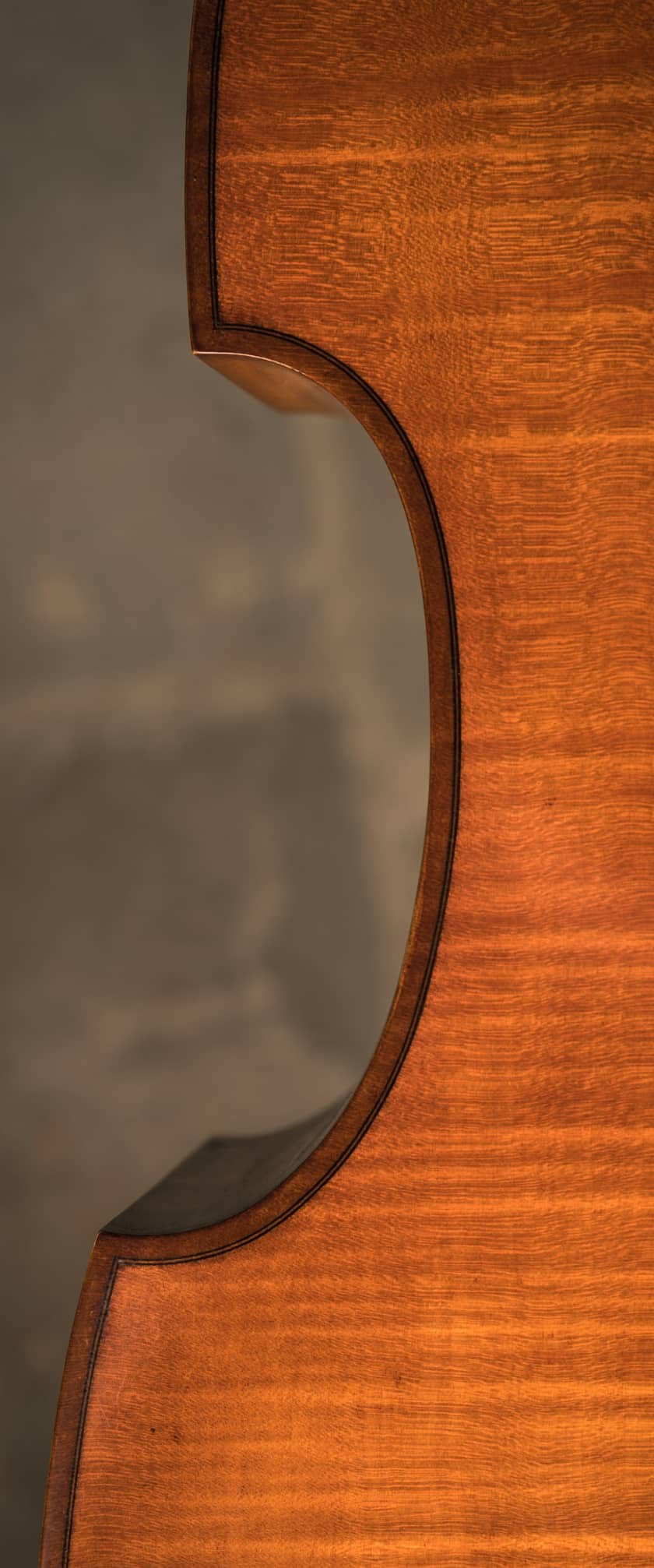
A cabinet of viols
As discussed above, the bass viol was played in various manners depending on the style, period and region. This versatility led the instrument makers to produce different bass viols. The consort bass was quite large. The division viol, used in 17th century England for playing melodies with elaborate variations and ornamentation, was smaller than a consort bass. Viols used for lyra repertoire were probably even smaller, sometimes even closer to the size of a tenor viol. In Italy, the viola bastarda was used to perform a highly decorated version of a madrigal.
In the late 17th century, the French added a seventh string to the bass viol, a low A, one fourth below the bottom D. This seven-string bass was used extensively as a solo and continuo instrument in France. The French also developed the pardessus de viole, a fourth higher than the treble, designed so that viol players could play violin music – it was for instance not socially acceptable for women to play the violin itself.
Are we playing original instruments?
Indeed, there are instruments from the past which have survived until today: some are in museums or private collections, others belong to happy viol players. Such instruments rarely made it through the ages without having been transformed: the wood is often attacked by bugs, some parts easily damaged by extreme changes of humidity or temperature…some viols have even been modified to become cellos after the da gamba family fell into disuse. Most (partially) original instruments need a lot of fixing and adjusting to be in a playable condition; they also cost a considerable amount of money.
Nowadays, most viols are copies, made by modern makers who draw their inspiration and techniques from original instruments.
Is there new music for viol?
Even though the majority of compositions for viol comes from the Renaissance and Baroque eras, the instrument is not limited to early music. Just like a saxophone (invented by Adolphe Sax in the 1840s) can play pieces by Johann Sebastian Bach (who died in 1750), the viol can play whatever music there is : it just needs to be transcribed to fit the instrument. Whether it will sound good or bad is a matter of taste!
Furthermore, the resurgence of interest in early music instruments over the last 70 years has brought several contemporary composers to write for the viol.
Sources:
The Early History of the Viol, Ian Woodfield, Cambridge University Press, 1984
Viola da Gamba Society of America
Britannica
Metmuseum
Audio: Ballet en rondeau
Marin Marais, Deuxième Livre (1701)
Recorded in Maria Saal in June 2020






